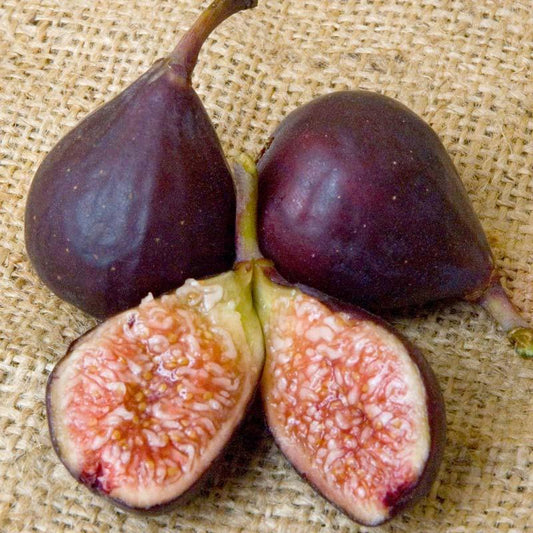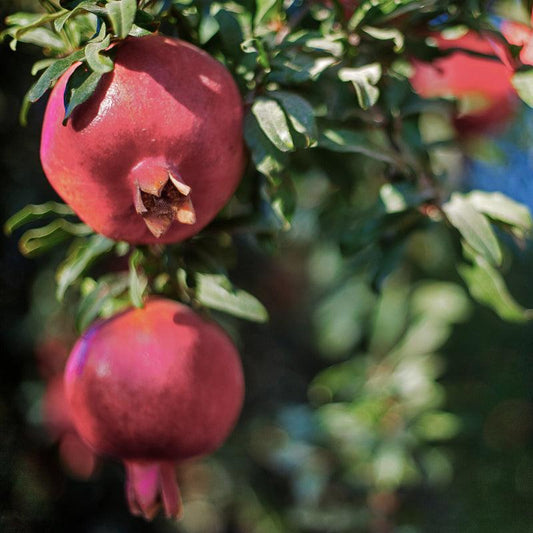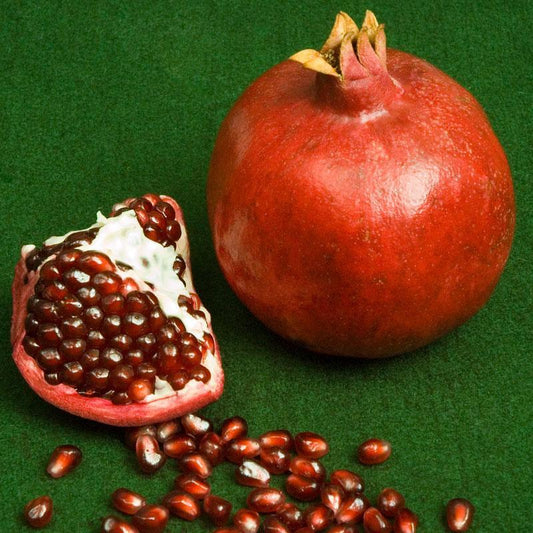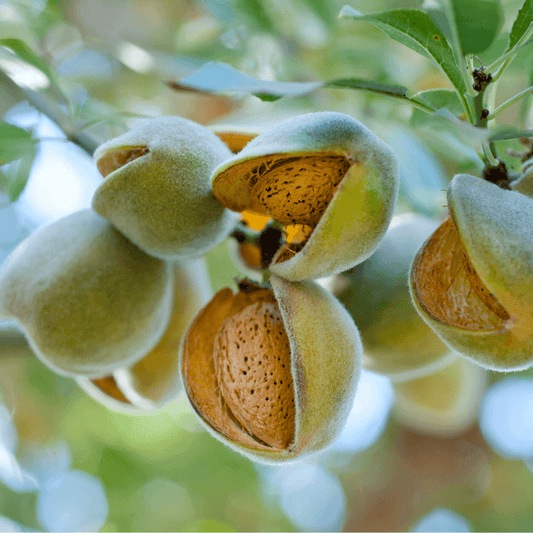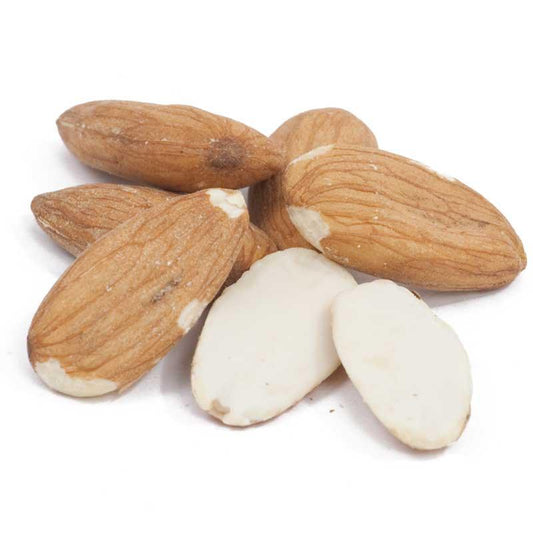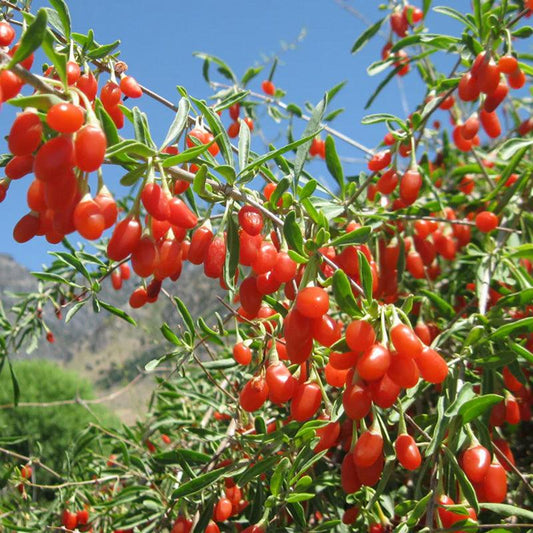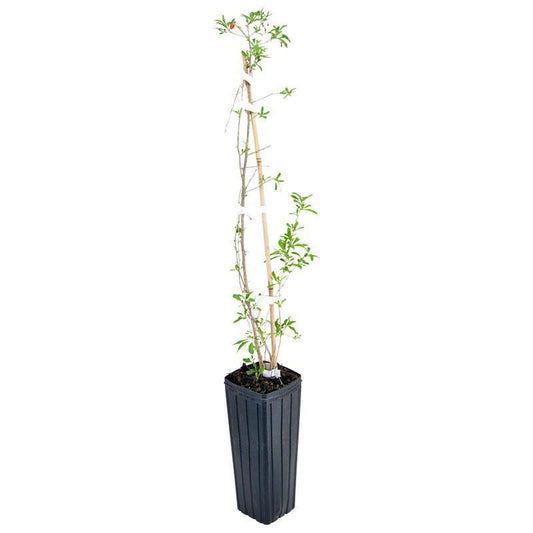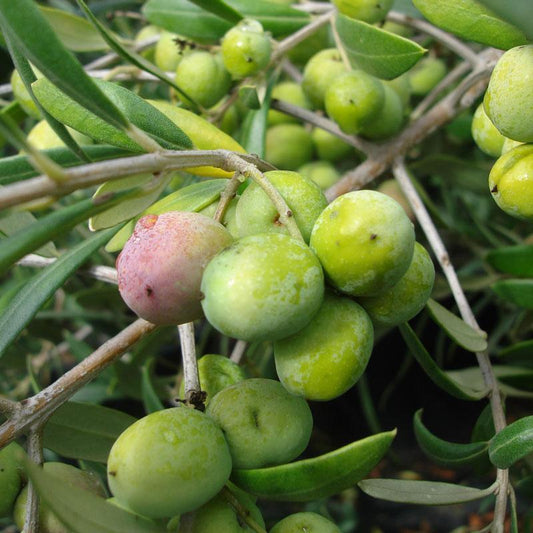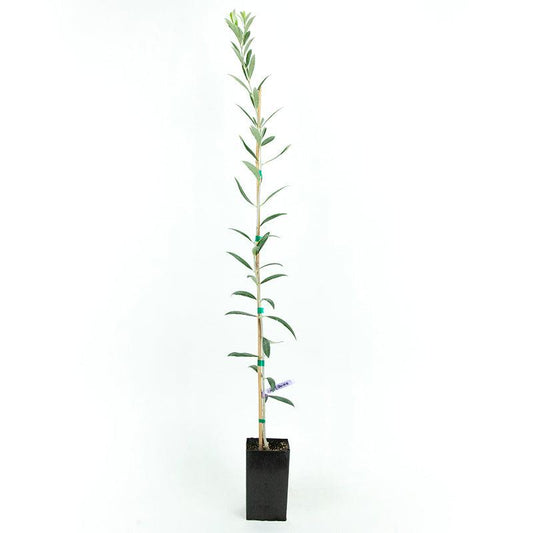Receiving Your Trees
When you receive your potted fruit and nut trees, they will be boxed securely. If you are not ready to plant the trees immediately place them in a sheltered location, safe from frost, like a root cellar, basement, or garage. It’s important to choose a place where the temperature stays between 38–45°F. This is important so the tree roots neither freeze, nor the tree break dormancy. It is essential that the young tree roots have plenty of time to become established before the tree begins its spring limb growth and bud break.
Upon receipt remove the trees from the pots inspect the roots. Any roots that are dead, withered or broken should be pruned back to healthy tissue, above any damage or withering. Figs and pomegranates do not like their roots disturbed, so don’t loosen the soil around their roots.
Planting Location
Fruit trees are a long-term investment and caring for them properly, right from the start, will ensure years of enjoyment and productivity. Maintenance will be greatly minimized as the tree matures, if you provided adequate early care.
Location: Carefully choose the planting location. Even an hour or two of extra shade a day can noticeably reduce growth and productivity. Fruit trees should also be planted in a location where air circulation (wind or breezes) is not impeded by natural or man-made windbreaks. If the tree requires a pollinator for fruit production, it is necessary for that pollinator to be established or planted in the same area, within 50 feet is recommended.
Drainage: Choosing a location with good soil drainage is very important, as poorly drained soil will stunt and may even kill trees by suffocating their root systems or harboring anaerobic soil pathogens. To test for proper drainage, the planting hole should be filled twice with water and allowed to drain; 12–14 hours is the maximum amount of time it should take for all of the water to drain out.
Soil Analysis: A soil analysis is also recommended to determine any soil deficiencies, but this can be delayed until the tree has begun to establish itself. A gradual application of proper soil amendments will suffice if proper sunlight and drainage are available from the start. However, in the long-term, calcium, magnesium, phosphorus and potassium along with sufficient nitrogen will significantly enhance tree health and fruit quality.
The tree’s root system will reach out from the trunk at a distance at least equal to the leafy canopy above and, to a depth of 4–6’, so it is very important that the soil around the tree be worked and amended in as large an area as possible. Do not amend the planting hole when planting figs and pomegranates. If amendment is necessary try to do it before the tree is planted and only around the planting site, not in the hole.
Planting

Dig a hole the same depth as the root system and two to three times as wide as the root system. Current research indicates that a saucer shaped hole with sides that slope gently upward, the same depth and three times the width of the root system stimulates the most root growth. Do not plant your trees too deeply, it is usually best to plant the tree to the same level it was planted in the nursery.
It is not recommended that you fertilize your tree at the time of planting. There are some regional exceptions, contact your local master gardeners to see if there are any recommended amendments for your area. Make sure that the sides of the hole have not been “glazed” while digging. If this has occurred, break through the “glaze,” roughing up the soil with a trowel or hand-held cultivating fork.
If gophers are a problem in your area, a wire gopher basket should be placed in the hole. This is especially important for fig trees, which are a favorite of gophers. Gophers are less of a threat to mature trees, but this protection could mean the difference between life and death for a young tree.
Two more factors must be considered before planting: wind and sun. If high winds will be a factor in your planting location, then the tree should be tilted slightly towards the wind’s prevailing direction. Do not overdo it, a slight tilt will suffice. To prevent sun damage to your new tree consider painting the trunk with a half and half mix of water and white latex paint or a white tree guard. Tree guards are preferred for fig trees to protect them from rabbit damage. Backfill with the soil.
Lightly compact the backfill with your hand, adjusting the tree gently so that the backfill reaches to the level the tree was planted to in the container for pomegranates and two to four inches above in the case of fig trees. The back fill should slope gently up so the crown of the tree is slightly higher than the surrounding soil, this will help prevent crown rot. Water the tree thoroughly and watch for settling. If undue settling occurs, elevate the tree very slightly to raise its height and release any subsoil air pockets. Figs and pomegranates like to be mulched, mulch them well and make sure the mulch starts four to six inches away from the trunk of the tree and extends a couple of feet past the canopy.
Fertility
Nitrogen fertilizers should be applied only after the first year. It should be applied in early spring, mixed into the top 6” of the soil in a broad ring approximately the diameter of the trees canopy (the “drip line” of the tree). In the long-term, calcium, magnesium, phosphorus, and potassium, along with sufficient nitrogen, will significantly enhance tree health and fruit quality.
High quality composts are also recommended as they contain a naturally balanced blend of nutrients, minerals, and probiotics. Natural kelp compounds are a great addition to fertilization regimes, whether added to irrigation water or used as a foliar spray between bud coloration and 1” fruit size.
Avoid synthetic fertilizers as these can destroy many of the naturally occurring beneficial soil organisms that nurture healthy root systems. Synthetic fertilizers also tend to produce overly lush and unnatural top growth that attracts common insect pests and micro-pathogens.
For a full range of high-quality organic soil amendments, fertilizers, and essential supplies to give your trees the best possible start, explore our Fertilizers & Growing Supplies collection. From slow-release organic fertilizers to specialized blends for fruit and nut trees, you’ll find everything you need to support healthy growth and abundant harvests.
Ongoing Tree Care
Staking may be necessary but should be done carefully. A young tree that struggles a little against the wind, without being blown over, develops tissue in its trunk that will strengthen the tree as it matures. Tightly staked trees that do not develop this tissue are at greater risk of wind damage as they grow older. Staking should provide emergency assistance to a young tree, but should not interfere with its natural capacity to resist wind.
To properly stake your tree, drive two sturdy poles deeply into the ground on opposite sides of the tree from each other. The two poles and the tree should demarcate a straight line directly into the prevailing wind. Using a plastic tie or cord attached securely to each pole, create a loose harness that will allow the tree sufficient movement in the wind at least a few inches in all directions. If rain is not timely, then occasional watering will be necessary.
Over-watering can kill young trees. Moist, workable soil is sufficient; soggy soil is dangerous and often fatal. As the tree matures, you will want to water deeply but infrequently; commercial orchardists water for more than 12 hours at a time, but sometimes only two or three times during a season. As your tree matures, pruning will become the most critical factor in its proper growth and development.
Do not prune fig trees heavily. For pomegranates only removal of dead wood or of suckers is necessary. If you do not desire a tree shape for your pomegranate let the suckers grow and the pomegranate will develop a bush shape.
Spraying fruit trees during the dormant season is an important preventative to many diseases and pest problems. Traditionally fruit trees are sprayed three times a year: at leaf drop (Thanksgiving), during full dormancy (New Year’s) and at bud swell (Valentine’s Day). Check our website for more information and a selection of natural and organic dormant sprays.
Container Growing
Figs and pomegranates are well suited to growing in containers. This allows you to grow these fruits in climates that are otherwise too cold or in small spaces.
Transplant the young tree into a twenty inch pot. To ensure that your tree’s roots do not get too hot, a smart pot (a 15 gallon smart pot is a perfect first container size) or a light-colored plastic pot are recommended containers. Ceramic is also highly suitable but can make transplanting difficult, however in areas with high winds the heaviness of the container will prevent the tree from blowing over. Another option in a high wind area or for more decorative appeal is to use a heavy cachepot over a smart pot or plastic pot.
Use a light potting soil that is not overly rich in nutrients. Figs and pomegranates do not like to be fertilized their first year in the ground. Re-pot your container fruit trees every three to five years. For the first re-potting you may want to move the tree from a twenty inch pot to a twenty-four inch pot. Replace one third of the soil each time you re-pot.
Water the trees regularly. Figs and pomegranates will drop their leaves if they do not receive adequate water. Drought stressed trees will not produce fruit. Fertilize them in spring after their first year of growing with an organic fertilizer that is lower in nitrogen and high in phosphorus, potassium and calcium. A fertilizer like Dr. Earth’s Bud and Bloom Booster 4-10-7 is a good container fruit tree fertilizer.
If you will be taking your tree inside for the winter wait until the tree is fully dormant. Then bring the tree into a shed or garage where it will be cool but sheltered. The temperature should not be consistently above 45°F or dip below 15–18°F. If the temperature in an unheated garage or outbuilding will dip below 15–18°F it is recommended you wrap the tree in a frost blanket. Water the tree lightly once a month to prevent the soil from becoming dry and powdery. Once the tree breaks dormancy in the spring bring it out immediately.
Pomegranates & Figs
Pomegranates and figs are not bare root, so disregard the instructions on inspecting, soaking, and pruning the roots. Instead, they are kept in pots with soil because they do not like their roots to be disturbed. Take special care to protect the roots when planting. Do not loosen the soil around the roots, which would shock the trees by exposing them to the air. If you are unable to plant in their permanent spot right away, follow the instructions on “Heeling In inside.” The only difference is that they are already in their container; just make sure they are kept in a cool place (38–45°F) and the soil is kept moist.
Resource Area: Planting & Growing Potted Fruit Trees
Planning to plant your trees soon? These tips cover planting strategies and timing for potted fruit varieties:
- Planting Fig Trees and Other Potted Fruit Trees – Step-by-step planting tips to get your trees off to a strong start.
- The Ultimate Guide to Receiving Potted Trees – What to expect when your tree arrives and how to prep for planting.




